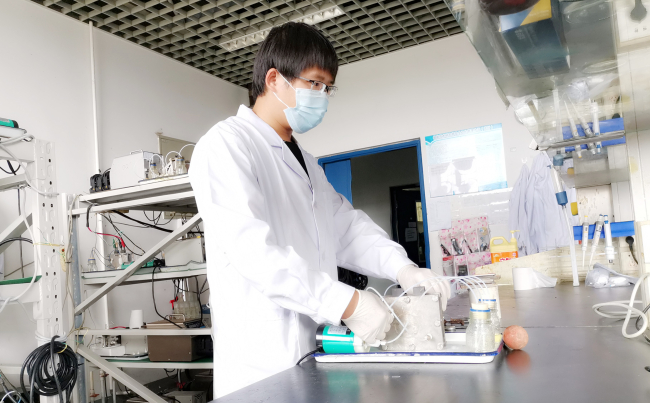
"I chose to study for a PhD here because of a summer camp in 2014," said XIE Congxin, who received a PhD from the Dalian Institute of Chemical Physics (DICP) of the Chinese Academy of Sciences and is now an Associate Professor at DICP.
In 2014, as a junior student at Shandong University, XIE participated in a summer camp organized by the Dalian Institute of Chemical Physics. At the time, he had not yet decided where to pursue his PhD. "I was qualified for admission to graduate school, be it a university or an institute; I had to make the most suitable choice," said XIE.
During the summer camp, XIE was deeply impressed by the strong scientific research strength, advanced facilities, and beautiful campus environment of DICP. He was not only impressed by the scientific charm of DICP, but also moved by its attentiveness and hospitality. "Very few institutions can take such details into consideration for their students," XIE said.
In 2016, XIE embarked on his research journey at DICP, joining the Division of Energy Storage, and studied under the supervision of Prof. LI Xianfeng. Throughout his doctoral research, XIE focused on energy storage, mainly engaged in the research of zinc-based flow battery systems, optimizing the problems existing in zinc-based flow battery cathode materials and constructing high-energy-density battery systems.
XIE completed his PhD in 2020 and began to work at DICP through the "Outstanding Young Doctoral Talents" program established by the institute, aiming to discover and cultivate outstanding young talents. Candidates eligible for this program are recent PhD graduates or individuals with a PhD and are under the age of 30. Selected candidates will be hired as Associate Professors and receive one million Yuan as scientific research start-up funding to support independent research. In addition, they will receive a personal housing subsidy of 500,000 Yuan, as well as financial support for overseas study and visit.
"The 'Outstanding Young Doctoral Talents' program provided me with a good start and facilitated my smooth transition from graduate student to researcher," XIE said. This not only alleviates the financial burden on scientific researchers to a certain extent but also provides a guarantee for them to concentrate on their futre scientific research, which is of great significance to the development and progress of young scientific researchers.

XIE does assembly and testing of flow batteries in the laboratory (Credit by XIE)
Whenever XIE talks about his research work, his eyes light up with passion. Research is the most meaningful aspects of his life for XIE.
"I have been dedicated to the solution to a problem for the past three years, which is how to improve the energy density of aqueous batteries," XIE said.
Aqueous batteries are mainly used for large-scale stationary energy storage. They use water as the solvent for the electrolyte, which greatly improves battery safety compared with traditional non-aqueous lithium-ion batteries. However, challenges are, their low energy density and low battery voltage due to the limited solubility of electrolytes.
"I asked myself a question: can we extend the application of aqueous batteries to the field of power batteries?" XIE said. "A critical first step in realizing this hypothesis is to increase the energy density of water batteries," he added.
XIE has made some progress in improving the energy density of aqueous batteries recently. The research results were published in the journal of Nature Energy on April 23, in an article entitled "Reversible multielectron transfer I-/IO3- cathode enabled by a hetero-halogen electrolyte for high-energy-density aqueous batteries".
XIE and his collaborators developed a multi-electron transfer cathode based on bromine and iodine with a specific capacity exceeding 840 Ah/L. In the full battery test, the energy density of the cathode reached 1200 Wh/L, providing new possiblities for the design of high-energy-density aqueous batteries.
"We used a mixed halogen solution of iodide and bromide as the electrolyte. This constructed a multi-electron transfer reaction that enabled a reversible and fast electrochemical reaction of I-/IO3- by introducing Br- and generating an intermediate state to build high energy density cathode," said XIE.
The reviewer of this article believed that "Overall, this work provides a significant advance in the growing field of aqueous batteries."
However, XIE said that their discovery was actually at its early stage, and there were still many challenes before it could be truly applied. "We also need to develop high specific capacity anodes and optimize key components such as membrane materials," said XIE.
XIE will continue his work on aqueous batteries, hoping to develop commercial aqueous batteries that can be applied in real life.

86-10-68597521 (day)
86-10-68597289 (night)

52 Sanlihe Rd., Xicheng District,
Beijing, China (100864)

